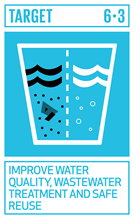Sustainable development relies on a constant and reliable source of freshwater. At the most basic individual level we rely on these sources to provide water for drinking, for washing and for food preparation. We also depend on these resources for irrigation, for recreation, to assimilate our waste water, for power generation and to support multiple industries. Freshwater ecosystems provide these services, but their ability to continue to do so is under threat. Pressures from human activities, such as the release of untreated effluent and changes to the surrounding catchment area that include agricultural intensification, deforestation and mining, cause damage to these fragile ecosystems.
Good ambient water quality is water of a certain standard that flows in our rivers, lakes and aquifers without causing harm to human or ecosystem health. This explanation sounds straightforward but, in practice, it is complicated to define good ambient water quality. Water quality varies constantly over space and time; for example, a measurement in a river one day may be different the next as a result of natural changes. This variability can sometimes make it difficult to determine whether water quality is in its natural state or is impacted by human activity. Also, although water quality criteria to maintain human health are relatively easy to define, aquatic ecosystems are much more diverse, and to define water quality that ensures the protection of the ecosystem is much more difficult. The third part of the problem is that there are thousands of substances that can be measured in freshwaters, and the effects of these on humans and ecosystems and how they interact with each other, is not fully understood.
The United Nations Environment Programme (UNEP) is the custodian agency for SDG indicator 6.3.2 and the Global Environment Monitoring Programme for Freshwater (GEMS/Water) is the implementing partner. All of the Goal 6 indicators are coordinated by UN Water under the Integrated Monitoring Initiative for Goal 6 (IMI-SDG6)

